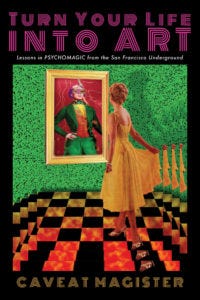
Rosalind Russel in the titular role of 1958’s Auntie Mame taught my seven-year-old, highly impressionable self an unimpeachable truth: “Life’s a banquet and most poor suckers are starving! Live, live, live!” Although her quest in this endeavor was facilitated by her fabulous wealth, her maxim seemed entirely doable during my childhood. In our innocence, all my friends approached life hungrily alongside me. As I grew older, this got harder and I saw people around me — coworkers, friends, acquaintances — begin to seemingly fall asleep at the wheel, numb to the world. Despite the sense of isolation this caused, I managed to maintain that appetite for discovery, thanks in no small part to unusual people and experiences I’ve encountered through the immersive world. Because of these, my world has expanded and I’ve discovered new facets of myself through the alternate lives and personas each experience persuades me to adopt, if only for an evening.
Through this lens, I approached Turn Your Life Into Art: Lessons in Psychomagic from the San Francisco Underground with enthusiasm and sympathy. Psychomagic is a complex, esoteric subject, but at its core it’s an approach to experience design that leverages Jungian psychology to provide connections to an audience member’s (unknowable) personal mythology. For those uninitiated in Jungian psychoanalysis, it focuses on the idea of a “collective unconscious,” which are symbols that recur across cultures and speak to universal motifs. As such, the details of psychomagical works are grounded in universally accessible, if, at times, thinly sketched tropes and symbolism. This proclaims to result in a higher probability of personal resonance for the greatest number of people. Turn Your Life Into Art aims to serve as a guide for applying the principles of psychomagic to both experience design and personal empowerment.
Outlined in three parts, the book is peppered with examples from immersive art (although author Caveat Magister may loathe that description). The first of these, the description and exploration of psychomagic, is well written and provides a basis for creating feelings of life-changing magic. I can see myself using principles of psychomagic to connect to a sense of wonder in our mundane world. Ritual is a powerful tool (as we’ve seen most recently in positive response to Bottom of the Ocean, although many immersive productions have historically incorporated it). There’s no reason why it shouldn’t be a powerful tool for all of us, even outside of a theatrical context. The advice to take magic as not entirely literal and not entirely figurative allows for moments of serendipity and awe; successful and evocative artistic works leverage this duality to create true profundity while keeping shy of delving into the kind of superstition that has been left in the past for a reason.
I also appreciate Magister’s warmth throughout the book. There’s a strong humanism to his work by seeing the value in elevating human consciousness and shaking people out of their modern slumber. Psychomagic is seemingly influenced by Dadaism, the European avant-garde movement of the early 20th century, which confronted the turbulence of a war-torn continent with surreal and abrasive artwork. Similarly, the psychomagical art scene he champions is frustrated by the apathy it recognizes in the world and seeks to revive and engage consciousness through shock and a sense of the miraculous. This can be abrasive (showers of rotting animal organ meats, sprayed over a horrified, if consenting, audience) or enchanting (a prayer answered in the form of a custom cocktail, never to be made again, reflecting the innermost feelings of the recipient). Either way, it provides new perspectives and modes of being.

Where the book sours for me, curdling much of the goodwill it generated in Part One, is in the second and third sections. These chapters attempt to outline a practical set of rules for creating psychomagical experience while outlining the history of the art scene Magister repeatedly asserts is dead. Magister has an incredibly prickly approach towards experience design, viewing psychomagical potential as the main metric by which to judge it. This leads to inevitable clashes with the vital topics of consent and safety in experiential art.
Get Blake Weil’s stories in your inbox
Join Medium for free to get updates from this writer.
SubscribeSubscribe
The first problem of consent is the most glaring. The aforementioned cascade of viscera isn’t problematic in this regard, as the audience consented to the experience. The offense that sticks out most prominently is an art project/funeral (1989’s “Illusions of Shameless Abundance”) in which Magister’s friends tied burning pianos to the concrete supports of the Golden Gate Bridge. They then exploded a confetti rain of human ashes over those crossing the bridge. Magister announces that the artistic collective behind this demonstration, Survival Research Laboratories, has made an enemy of the San Francisco Public Fire Department as if it were a badge of honor. A quick perusal of their Wikipedia page confirms that they haven’t killed anyone yet, but it also highlights consistent accidents and police attention to continued and unsanctioned public work with pyrotechnics and explosives.
Another example is an artistic prank involving two men dressed as Abraham Lincoln. Sent into a public restaurant, they battled over which one was the “real Abe,” and thus entitled to a “reservation” for the Abraham Lincoln party. They demanded that the hostess, who was not in on the joke, settle the debate. On the one hand, yes, it’s funny, provocative, and a surreal moment making an incursion into reality. On the other hand, it can be cruel to force someone into such a situation. To invite one into abrasive art is defensible, but to inflict it upon the world is assault; society can’t be berated into consciousness. On the contrary, the wonder granted to me by immersive theatre productions has been through acts of gentle seduction, offering worlds of possibility and, if only for fleeting moments, a belief in the divine. Although Magister briefly pays lip service to the idea that consent is tricky, he’s ultimately carried away by what he sees as the power and potential of these works, audience willingness be damned.
The second issue of safety is more nuanced. It’s true that guardrails can impact the verisimilitude of an immersive work or create an immersion-breaking need to suspend disbelief. However, a line must be drawn somewhere. The aforementioned work of the Survival Research Lab, which included setting public fires in parched, fire-prone California, seems beyond the pale. In contrast, there is an understanding that entering the Playa of Burning Man incurs a certain level of risk from the natural environment and a lack of law enforcement. Magister champions Burning Man’s anarchic ethos across the experiential space. In doing so, he disregards the tension between the obvious demands of urban art with the freedom of the remote desert in which this artistic philosophy flourishes. Eventually, even Burning Man has had to contend with the long history of assault that this laissez-faire attitude has allowed.
Throughout the book Magister returns to a metaphor about the need for danger. He asks the reader to imagine the greatest ride at Disney World, the most thrilling, satisfying, platonic ideal of a theme park ride. He then states that this ride would pale in comparison to the thrill and life-changing experience of breaking into Disney World. Well…yes? This is where it becomes nearly impossible to find the exact words to engage with Magister’s work. He’s right, of course. It would be thrilling to break into Disney World. But what about laws and the rights of others? It doesn’t matter how true his statements might be when the advice veers from the concrete (i.e. psychomagical potential thrives in non-fiction environments) to unactionable calls for “danger management” while flagrantly disregarding laws and ignoring the potential for danger (i.e. arson). The risk is introduced and the danger is acknowledged, but what to do from there is never specified. Methods of managing risk are never articulated; creators are merely urged to somehow become more comfortable navigating it. Perhaps with that ethos you could make a smaller experience that likely won’t kill anyone, but it’s never going to scale.
Magister explicitly does not care if art can scale and he doesn’t seem to care about the ethics of making this kind of art to begin with. Far beyond the potential to reach a broad audience or follow safety guidelines and legal requirements, the “quality” of the art is paramount to him. Magical traditions often demand an element of sacrifice, be that literal or just time and devotion, and psychomagic, as he constructs it, is no exception. By Magister’s estimation, immersive theatre is a neutering of psychomagical design, brought on by the advent of respectability politics and the lures of capitalism. In his words, one must be willing to ruin their life to truly receive psychomagic’s blessing; he refers to his artistic collective as “The Life Ruiners Club.” While I can understand his nostalgia for the “anything is possible days” of early experiential art and a desire for a return to form, and he concedes that the scene changed for a reason, the absence of a scene makes his suggestions even more dangerous. Without the guidance of an experienced group, like the Survival Research Labs, disaster feels inevitable if his advice is embraced at the individual level.
I’ll conclude my disagreement by saying that the more conventional, “tamed” immersive theatre, LARP (Live Action Role Playing), and experiential art that Magister scoffs at has changed my life. I’ve discovered aspects of myself and capabilities thereto unknown; a capacity for empathy and kindness that I’ve been empowered to exercise. The sacrifice and level of difficulty Magister insists true psychomagic requires only seem to serve an artificial exclusivity to the magic his book claims to champion. We all deserve the tools to change our lives, even those unwilling to go to jail or the grave for it.
Psychomagic is challenging and complex. While Turn Your Life Into Art has convinced me of its value in the world, it hasn’t sold me on the approach to achieve its effects. No matter how difficult it is, trying to make magic “easier” by embracing its destructive potential only gives it a Pyrrhic power. In 1904, Aleister Crowley, an English magician and occultist, wrote The Book of the Law. After reading Magister’s book, I sense, in a Western esoteric tradition, Crowley’s famous ethos (“Do what thou wilt shall be the whole of the law”) has led to what I see as a selfish application of magical practice. If immersive creators serve, as Magister asserts, as a combination of priest, magician, and therapist, I suggest they take an older maxim familiar to those in medicine: “First, do no harm.”
Turn Your Life Into Art: Lessons in Psychomagic from the San Francisco Underground By Caveat Magister (Benjamin Wachs); Burning Man; 388 pages; $21.99 paperback (IndieBound, Amazon) /$9.99 e-book (Amazon)





















Discussion